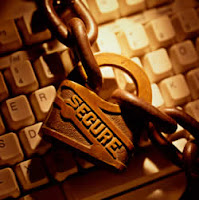 Why we need to safeguard our personal and financial data while online?
Why we need to safeguard our personal and financial data while online?
Is it real? Our personal and financial data are 100% safe with them. What your opinion? Emm.. Do you receive junkmail before in your mailbox? 9 out of 10 people will say yes where they found some "nonsense" email which send from XXX company which they start to think did I give or write my e-mail address to them before. If not how they get our email address and even know our name correctly (personal data).
Once again, its prove that internet is not a safe place where millions of computer are connected and the data transfering on sending back and forth through different server on a same time. So, the signifiant increasing numbers of crimes on stealing personal and financial data from third party by using the advanced of technology.Thus, it is dangerous that for every users to disclose some of his personal data in internet with available software in market to prevent hackers to intercept and use those privacy information act as you and use it to purchase things.
So, How can we prevent of being one of the victim ?
1. Secure your mailbox.
Remove incoming mail promptly.Avoid putting bill payments in your mailbox for pickup by a postal carrier ,unless it is unlocked box, drop outgoing payments in Postal Servcies collection boxes.
 2. Share your personal information cautiously
2. Share your personal information cautiouslyUsers must cautious on sharing or listing out their privacy personal data including social security numbers, driver's license number and credit card numbers. Don't give out information unless you know the pary with whomyou are dealing with.
3.Review your credit card report and correct any errors.
Do it again each month and year as you receive the bank billing statement with yours receipts to make sure you have not been billed for fraudulent purchasas. If spot any suspicious transactions or charges or duplicated charges where unknown .Then, pleace contact the bank immediately.
4. Store card receipts and other important documents in a safe place.
All those documents including cancelled checks, new checks and account statements should keep properly and not simply throw out. Users need to shred it first before they throw it out. Also shred offers for preapproved credit cards before discarding them.
5.Strong password.
Users should not reveal any passwordthat related our personal and financial data to the other party simply and easily. Users should remembers their own password while log in in any online website and log off while they leave to prevent the other party steal it. Avoid using passwordsthat are easily to guess such as your name , nric number, date of birth, your mother or father name and others. Password that you set please never ever write it down on the paper and out inside in your wallet or beg because it might be steal by theft then they will get your password easily.
6.Use own computer.
When you key in any private information included personal and financial data please doit on your own computer and at home. This is the most safety place instead of work or public maachine to prevent any chances of your own data explode out.
7.Resits using free wireless connections particulary in cybercafes, airports and other public place to check peersonal information.
8. Purchase and use the updated antivirus and antispyware software to get an extra protection.
Remember anything will happen in anytime so what we can do is just prevent by some software to reduce the chances of our personal and financial data fade out.








